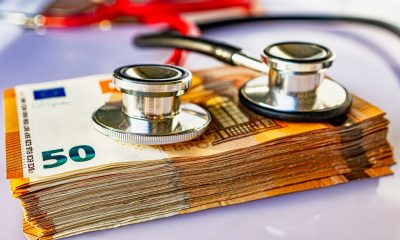Impact Investing
Marine Ecosystem Restoration Interventions Generate Economic Value and Employment, Study Shows
Marine ecosystem restoration is effective and economically valuable, succeeding in over 64% of cases worldwide. It boosts biodiversity, mitigates climate change, and creates jobs. Despite high deep-sea costs, restoration is feasible even in impacted areas. Backed by the Nature Restoration Act, Europe aims to restore 90–100% of degraded marine habitats by 2050, fueling innovation, investment, and sustainable growth.

Restoring marine ecosystems generates economic value and it works. This is demonstrated by a study published in Nature Communications and conducted by a group of Italian and 15 other national researchers who analyzed the results of 764 marine ecosystem restoration interventions around the world. The restored habitats include seagrass meadows, tropical coral reefs, Mediterranean coralligenous, macroalgal forests, animal forests, mangroves and even deep environments.
This analysis showed that marine ecosystem restoration is highly successful in over 64% of cases
Ecological restoration interventions were surprisingly effective even in areas where human impact has not been completely removed, demonstrating that it is possible to start restoration also in sites of national interest, such as the industrial complex of Bagnoli (Naples) or in areas characterized by multiple impacts such as the Adriatic. These results demonstrate the immediate feasibility of a global “blue restoration” plan also for deep-sea ecosystems affected by trawling.
The benefits of marine ecosystem restoration, according to the calculations reported in this study, are multiple, from climate change mitigation to employment.
Furthermore, the economic benefits can make investments in the sector profitable. For example, the restoration of macroalgae forests produces a value between 55,000 and 190,000 euros/hectare/year. Those of marine plants can produce about 20,000 euros/hectare/year. However, the costs of restoring deep marine environments remain high, which can cost 5 to 50 times more than coastal ecosystems. This could make mining activities of polymetallic nodules not cost-effective given the restoration costs that are necessary following these highly destructive activities.
Currently, already over 350 European companies are ready to launch themselves in this sector that will see a growing market in the field of environmental restoration in the coming years also thanks to the Nature Restoration Act. The technologies developed for restoration will also be useful to compensate for the damage to marine habitats due to the development of ports, dams, marine cables, oil platforms, offshore wind and other human activities that can cause environmental impacts.
“The development of new technologies for the restoration of marine ecosystems today allows us to intervene on increasingly larger areas and to restore even environments subject to heavy pollution. The effectiveness of ecological restoration interventions at sea is such that it leaves no doubt about the possibility of aiming with conviction in this direction” says Roberto Danovaro of the Polytechnic University of Marche – NBFC and coordinator of the study.
Over the last 100 years, humans have destroyed or damaged a large part of marine ecosystems. Our country is no exception, where more than 30% of coralligenous and marine plant meadows have been damaged by human impacts and brown algae forests and oyster beds have lost up to 80% of their extension.
The benefits of marine ecosystem restoration, according to the calculations reported in this study, are multiple, from climate change mitigation to employment
The European Commission has strongly supported the Nature Restoration Act, which will lead all member states in the coming months to define the objectives and priorities for the restoration of marine ecosystems damaged by man. In particular, the law will push EU member states to restore 20% of degraded marine habitats by 2030, 60% by 2040 and 90-100% by 2050.
To create widespread consensus and develop a national plan for the restoration of marine ecosystems and at the same time incentivize investments in this direction, it is necessary to demonstrate that the interventions are successful and economically advantageous. In this way, it will also be possible to involve civil society and private companies to stimulate the development of new business sectors and new employment. For example, in the European Project REDRESS , restoration interventions are leading to the development of new technologies, with robots able to operate in deep environments.
“This is an important contribution to the research of the National Biodiversity Future Center, the large PNRR project that involves the main Italian research institutions and universities. In fact, a sector of the project is dedicated to the restoration and conservation of marine ecosystems,” added Simonetta Fraschetti of the University of Naples Federico II and head of Spoke 1 NBFC,.
“Italy has the skills and capabilities to effectively facilitate the recovery of many of the degraded habitats that increasingly determine a net loss in terms of ecosystem goods and services, and which on the contrary are so important for strategic sectors of the Italian economy such as blue tourism.”
__
(Featured image by Cristian Cojocarita via Unsplash)
DISCLAIMER: This article was written by a third party contributor and does not reflect the opinion of Born2Invest, its management, staff or its associates. Please review our disclaimer for more information.
This article may include forward-looking statements. These forward-looking statements generally are identified by the words “believe,” “project,” “estimate,” “become,” “plan,” “will,” and similar expressions. These forward-looking statements involve known and unknown risks as well as uncertainties, including those discussed in the following cautionary statements and elsewhere in this article and on this site. Although the Company may believe that its expectations are based on reasonable assumptions, the actual results that the Company may achieve may differ materially from any forward-looking statements, which reflect the opinions of the management of the Company only as of the date hereof. Additionally, please make sure to read these important disclosures.
First published in ESG NEWS. A third-party contributor translated and adapted the article from the original. In case of discrepancy, the original will prevail.
Although we made reasonable efforts to provide accurate translations, some parts may be incorrect. Born2Invest assumes no responsibility for errors, omissions or ambiguities in the translations provided on this website. Any person or entity relying on translated content does so at their own risk. Born2Invest is not responsible for losses caused by such reliance on the accuracy or reliability of translated information. If you wish to report an error or inaccuracy in the translation, we encourage you to contact us

-

 Crypto2 weeks ago
Crypto2 weeks agoCardano Fork Crisis Exposes Critical Vulnerability and Shakes Trust
-

 Cannabis4 days ago
Cannabis4 days agoSeven Years On: Canada’s Cannabis Boom Delivers Billions but Falls Short on Promises
-

 Crypto2 weeks ago
Crypto2 weeks agoXRP Shows Strength Amid Market Turmoil
-

 Markets6 days ago
Markets6 days agoCotton Prices Firm as Demand Lags and Global Production Outlook Improves















